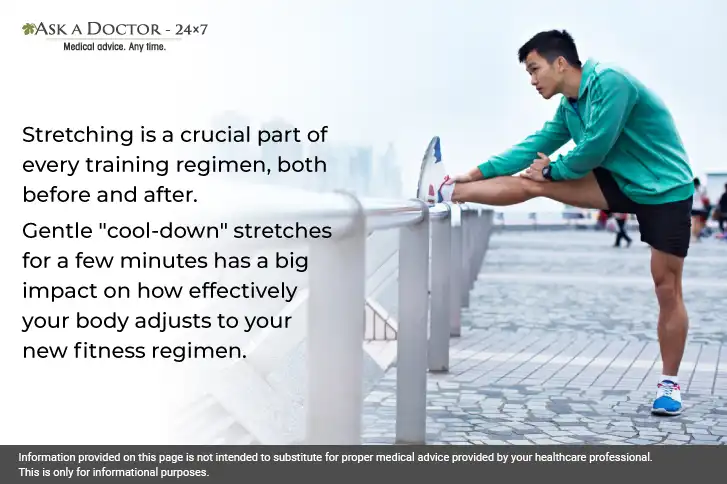Why One Should Never Skip Cool Down Exercises
A cool-down stretch is a crucial part of your workout as this is the last stage of exercise when your body slowly starts cooling down and repairing the muscle exertion it gets throughout the workout. Cool-down involves continuing your training activity for around five minutes but at a slower speed and reduced intensity. While your muscles are still warm, these exercises help you stretch them and return your breathing and pulse rate to normal.
Let’s read together to understand more about the cool-down exercises.
Why Cool Down Exercises Are So Important?

Stretches post-workout are known as "cool-downs" for a reason. They gradually and gently bring your vital numbers like heart rate, etc. back to normal. By doing this, you can avoid having your blood pool too quickly and prevent light-headedness and potentially dangerous falls. Your body may experience shock if you suddenly quit working out because it uses a lot of energy to pump blood through your system. It is crucial to allow your body to gradually cool down after physical activity and return to its resting state. To understand the effects of cool-down and warm-up exercises elaborately, read below.
Cool-down exercises are important because they help:
1) Return your heart rate and blood pressure to their resting levels
The main benefit of cool-down exercises is that they reduce physiological reactions, such as variations in blood pressure, heart rate, and breathing response.
2) Reduce muscle cramping
After an intense bout of exercise, there is an accumulation of lactic acid within the system. This lactic acid build-up during exercise can lead to muscle cramps, depending on how high your heart rate is. For example, executing repeated sprints can cause your heart rate to drop into an anaerobic condition and cause lactic acid to build up in your muscle tissue. By cooling down post-workout, you’re giving your body time to clear out some of the lactic acid from your system.
3) Prevent delayed onset muscle soreness
Delayed onset muscle soreness (DOMS) results from exercise-induced microtears in the muscle fibers, which manifest 24 to 48 hours later. It is normal to have some pain after exercising, especially if you are new to the exercise or are doing weight training. However, significant levels of DOMS are uncomfortable and can be rather incapacitating. For two to three days, DOMS may also indicate overtraining, illness, or an indication of an impending injury. One of the best ways to reduce the DOMS impact is to do a cool-down workout.
4) Boosts Flexibility
After working out, when your muscles are still warm, it's a good idea to stretch because your warmed-up muscles may flex more than usual. Your flexibility may improve as a result, raising your level of fitness. Cool-down stretching enhances one's capacity for daily mobility while handling the day-to-day regular tasks.
5) Relieves Stress
Cool-down exercises are a fantastic way to decompress and look after yourself after a stressful day. A regular workout regime promotes the release of endorphins, or the "feel good" hormones dopamine and serotonin, which are highly beneficial for both physical fitness as well as mental wellness. Cool-down exercises must be a crucial part of your workout regime because they allow the body to gradually return to homeostasis, or a resting, balanced condition, after your workout. Thus allowing the body to fully benefit from the calming, euphoric effects that these neurochemicals have on our body.
5 Cool-Down Exercises One Must Try
These five cool-down exercises will help bring your heart rate down and loosen your muscles after a challenging workout:
1. Quad Stretch
Stretches for the quadriceps can improve blood flow and reduce muscle stress. They're very helpful just after a run.
How To Do It?
A. Commence in a standing position. Bring your heel up to your buttocks and bend one knee. Using one or both hands, grasp your ankle.
B. Try maintaining the alignment of your knee with your body by pressing your hips forward.
C. Repeat on the other side after holding for 20 to 30 seconds. Finish two or three rounds per side.
2. Chest-Opener Wall Stretch
Chest-opening poses help you train your shoulders, back, and neck for better posture and flexibility.
How To Do It?
A. Stand facing a wall, ideally at a corner. Place the entire inside of your right arm and palm up against the wall.
B. Rotate the rest of your body to the left (away from the wall) to feel a stretch through the front of your right arm from the bicep, through the shoulder, to the chest. Hold for 20 seconds.
C. Repeat on the opposite side.
3. Child’s Pose
Child pose stretches the back, hips, and shoulders while promoting relaxation
How To Do It?
A. Start on your hands and knees, then sit your butt back on your heels.
B. Drop your head and walk your hands forward as far as you can without your butt lifting from your heels.
4. Cow-Cat Pose
The cat-cow stretch promotes spinal mobility and helps release tension in the back.
How To Do It?
A. With your back flat, begin on your hands and knees.
B. Tuck your chin into your chest like a cat and arch your back upward towards the ceiling. Remain in this position for a few seconds then go back to normal.
C. Lower your belly to the floor while raising your tailbone and chin to the ceiling in a cow position. Proceed to move slowly and deliberately back and forth.
5. Spinal Twist
It's important to keep your back and core muscles loose as these are used in practically all forms of exercise. A good approach to do this is with a basic spinal twist.
A. Take a seat with your legs extended in front of you on the floor or a mat.
B. Lie flat on the ground beside your knee or thigh, with one foot crossed over the other leg.
C. Twist towards your leg while hugging your knee with the opposing arm. Repeat it on the opposite leg.
Our body and mind equally benefit from these cool-down exercises. Moreover, cool-down exercises also help to put back the body into its balanced stature, thus assuring that our breathing and heart rate will return to normal.
Conclusion
After an exercise, a cool-down workout can also increase the range of motion, decrease soreness and stiffness, and enhance circulation. Make sure these stretches are appropriate for you, and talk about them with your healthcare provider as you would with any physical activity.
If you have any queries related to physical fitness and workout or want to ask specifically about cool-down exercises, then Ask a Sports Medicine Specialist at Ask a Doctor, available 24x7.
Recently Answered Questions Related to Exercises and Fitness
Disclaimer: Information provided on this page is not intended to substitute for proper medical advice provided by your healthcare professional. This is only for informational purposes.
Ask a Specialist
Recent Questions


